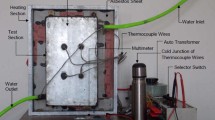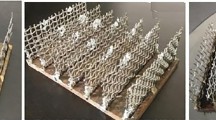Abstract
The primary aim of the paper is to compare the different nongradient methods of multiobjective optimization for optimizing the geometry parameters of a cylindrical fin heat sink. The methods studied for comparison are Taguchi-based grey relational analysis, ε (epsilon) constraint method and genetic algorithm. The various responses that have been studied are electromagnetic emitted radiations, thermal resistance and mass of the heat sink. Since the responses are obtained using complex simulation softwares (HFSS—Ansoft for emitted radiations and CFD—Flotherm for thermal resistance), there is no way of calculating the derivates of the objective functions. Hence, the Taguchi design of experiments design is used to derive the linear regression equations for the responses studied, which are then taken as the objective functions to be optimized. A new hybrid method known as Taguchi-based epsilon constraint method has been proposed in this paper for obtaining nondominated Pareto solution set. The results obtained using the proposed method show that the Pareto optimal set is competitive in terms of diversity of the solutions obtained. It is not likely that there exists a solution, which simultaneously minimizes all the objectives using any of the multiobjective techniques implemented. The value path analysis has been done to compare the trade-off among the design alternatives for the chosen multiple objective parameter optimization problem.
Similar content being viewed by others
References
Rao T (2001) Fundamentals of microelectronic packaging. McGraw-Hill, New York
Shih CJ, Liu GC (2004) Optimal design methodology of plate-fin heat sinks for electronic cooling using entropy generation strategy. Comp Packag Tech IEEE Trans 27(3):551–559
Philippe Sochoux, Jinghan Yu, Alpesh Bhobe, Federico Centola (2008) Heat sink design flow for EMC. Design Con 2008. IEC Publications, pp 1–27.
Visser JA, de Kock DJ, Conradie FD (2000) Minimisation of heat sink mass using mathematical optimization. IEEE Semiconductor Thermal Measurement and Management Symposium, pp 252–259
Shah A, Sammakia B, Srihari H (2002) A numerical study of the thermal performance of an impingement heat sink fin shape optimization. ITHERM 2002:298–306
Chen C-T, Ching-Kuo Wu, Hwang C (2008) Optimal design and control of CPU heat sink processes, components and packaging technologies. IEEE Trans 31(1):184–195
Chiang K-T, Chang F-P, Tsai T-C (2006) Optimum design parameters of Pin-Fin heat sink using the grey-fuzzy logic based on the orthogonal arrays. Int Comm Heat Mass Tran 33:744–752
Chou C-C, Liu N-M, Horng J-T, Chiang Ko-Ta (2009) Designing parameter optimization of a Parallel-Plain Fin heat sink using the grey-based fuzzy algorithm with the orthogonal arrays. Int J Therm Sci 48:2271–2279
Manivannan S, Devi SP, Arumugam R, Sudharsan NM (2010) Multi-objective optimization of flat plate heat sink using Taguchi-based Grey relational analysis. Int J Adv Manuf Technol. doi:10.1007/s00170-010-2754-8, Springer publications
Manivannan S, Arumugam R, Sudharsan NM, Prasanna DS (2010) Taguchi based linear regression modeling of flat plate heat sink. J Eng Appl Sci 5(1):36–44. doi:10.3923/jeasci.2010.36.44,5(1)
Andersson J (2000) A survey of multiobjective optimization in engineering design. http://citeseerx.ist.psu.edu/viewdoc/summary?doi=10.1.1.8.5638
Bäck T (1993) An overview of evolutionary algorithms for parameter optimization. Evol Comput 1:1–23
Saravanan R et al (2003) Machining parameters optimization for turning cylindrical stock into a continuous finished profile using genetic algorithm and simulated annealing. Int J Adv Manuf Tech 21(1):1–9
Montgomery DC (2001) Design and analysis of experiments. Wiley, New York
Hajela P (1999) Nongradient methods in multidisciplinary design optimization—status and potential. J Aircraft 36:255–265
dos Santos Coelho L, de Andrade Bernert DL (2010) A modified ant colony optimization algorithm based on differential evolution for chaotic synchronization. Expert Syst Appl 37(6):4198–4203
Keeney R, Raiffa H (1976) Decisions with multiple objectives—preferences and value tradeoffs. Wiley, New York
Deng JL (1982) Control problem of grey system. Syst Contr Lett 1(4):288–294
Manivannan S, Devi SP, Arumugam R (2011) Optimization of flat plate heat sink using genetic algorithm. 1st International Conference on Electrical Energy Systems (ICEES). doi:10.1109/ICEES.2011.5725306
Mavrotas G (2009) Effective implementation of the ε-constraint method in multi-objective mathematical programming problems. Appl Math Comput 213:455–465
Schilling DA, Revelle C, Cohon J (1983) An approach to the display and analysis of multiobjective problems. Socioecon Plann Sci 17(2):57–63
Author information
Authors and Affiliations
Corresponding author
Rights and permissions
About this article
Cite this article
Devi, S.P., Manivannan, S. & Rao, K.S. Comparison of nongradient methods with hybrid Taguchi-based epsilon constraint method for multiobjective optimization of cylindrical fin heat sink. Int J Adv Manuf Technol 63, 1081–1094 (2012). https://doi.org/10.1007/s00170-012-3985-7
Received:
Accepted:
Published:
Issue Date:
DOI: https://doi.org/10.1007/s00170-012-3985-7




